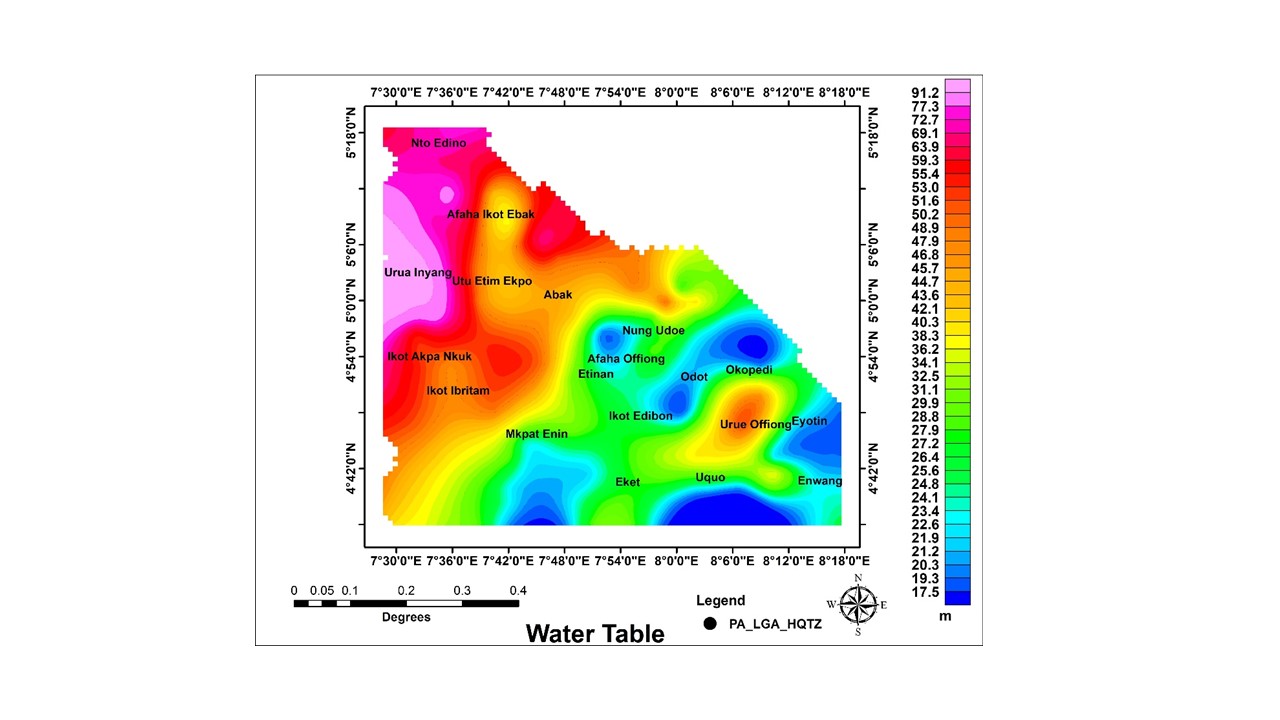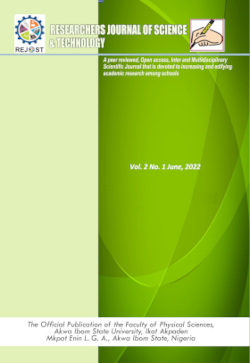Hydrogeophysical and Hydrogeological Characterization of Groundwater in Parts of the Benin Formation, Akwa Ibom State, Nigeria: Implications for Sustainable Water Resource Management
Keywords:
Groundwater characterization, Electrical resistivity, Aquifer properties, Groundwater flow directionAbstract
This study investigates the hydrogeophysical and hydrogeological characteristics of groundwater within Nigeria’s Benin Formation, aiming to support sustainable water resource management. Through 80 Vertical Electrical Soundings (VES) using a Schlumberger array, the study identified three key subsurface layers: topsoil with high resistivity (1,200–5,000 Ωm), an unsaturated zone (1,500–2,000 Ωm), and main aquifer units (1,000–3,500 Ωm), predominantly composed of medium to coarse-grained sands and gravels. The dominant resistivity curve types are KH, HK and KQ (63%), which indicates a high-energy sedimentary terrain with mainly sandy formations or unconsolidated sediments with a mixture of clayey formations. These curve types indicate an alternating layer of conductive (clay) and resistive (sand) materials, reflecting a heterogeneous subsurface. This sand-clay intercalation provided for the unconfined and semi-confined auriferous units. The sandy aquifer units, located at depths between 20 and 75 meters, exhibit high groundwater potential, particularly in the central and northern parts of the Formation. Groundwater flow analysis indicated a predominant north-to-south direction, influenced by regional topography and subsurface lithology, with key recharge zones identified in the northern and central regions. The findings underscore the need for the protection of these recharge zones and careful management of extraction rates to maintain groundwater sustainability. This combined method, which uses both geophysical surveys and hydrogeological analysis, presents a complete framework for the management of groundwater in the Benin Formation.
References
Abija, H., & Nwankwoala, H. (2018). Electrical resistivity method for aquifer characterization in sedimentary environments. Journal of Hydrogeo-physics, 12(3), 45-58.
Akanbi, T. (2018). Groundwater assessment using resistivity methods in sedimentary basins. Hydrogeological Journal, 14(2), 78-92.
Amah, A., Okoro, C., & Eze, J. (2012). Groundwater exploration challenges in Nigeria: A case study of borehole failure rates. Journal of Water Resources and Environmental Studies, 9(4), 112-124.
Amajor, L. C. (1991). Aquifers in the Benin Formation (Miocene-Recent), Eastern Niger Delta, Nigeria: Lithostratigraphy, hydraulics, and water quality. Environmental Geology and Water Sciences, 17(2), 85–101.
Bayowa, O. G., Adeyemi, G. O., & Ogungbe, A. S. (2014). Application of geospatial techniques in groundwater resource assessment in Nigeria. Journal of Water Resource Management, 28(5), 1123–1138.
Dobrin, M. B., & Savit, C. H. (1988). Introduction to geophysical prospecting (4th ed.). McGraw-Hill.
Edet, A. (1993). Hydrogeology of the Benin Formation and its groundwater potential. Journal of African Earth Sciences, 17(2), 217–229.
Ekanem, A. M. Ikpe E. O, George, N. J. & Thomas J. E. (2022a). Integrating geoelectrical and geological techniques in GIS‑based DRASTIC model of groundwater vulnerability potential in the raffia city of Ikot Ekpene and its environs, southern Nigeria. International Journal of Energy and Water Resources https://doi.org/10.1007/s42108-022-00202-3
Ekanem, A.M., George, N. J., Thomas, J.E. & Nathaniel, E. U., (2020) Empirical Relations Between Aquifer Geohydraulic–Geoelectric Properties Derived from Surficial Resistivity Measurements in Parts of Akwa Ibom State, Southern Nigeria. Natural Resources Research, 29(4), 2635-2646. https://doi.org/10.1007/s11053-019-09606-1
Ekanem, A. M., George, N. J., Thomas, J. E.& Udo, I. G., (2024) Geophysical Investigation of Aquifer Flow Unit Characteristics in Northern Parts of Akwa Ibom State, Southern Nigeria on February 27, 2024. Results in Earth Sciences, https://doi.org/10.1016/j.-rines.2024.100017.
Ekanem, K. R., George, N. J. & Ekanem, A. M. (2022b). Parametric characterization, protectivity and potentiality of shallow hydrogeological units of a medium-sized housing estate, Shelter Afrique, Akwa Ibom State, Southern Nigeria. Acta Geophys. https://doi.org/10.1007/-s11600-022-00737-3
El-Sayed, A., Hassan, R., & Mohammed, T. (2023). Magnetotelluric surveys for deep aquifer exploration: Case study from North Africa. Geophysical Research Letters, 50(1), 1–12.
Esu, E. O., Udo, O., & Bassey, I. (1999). Hydrogeological framework and groundwater flow patterns in southeastern Nigeria. Environmental Geology, 21(3), 199-210.
Evans, U. F., Akpan, A. E., George, N .J., Obot, I. B. & Ikot, A. N. (2010). A Study of the Superficial Sediments and Aquifers in Parts of Uyo Local Government Area, Akwa Ibom State, Southern Nigeria Using Electrical Sounding Method. E-journal of Chemistry, India, 7 (3), 1016-1022.
Fan, Y., Li, H., & Miguez-Macho, G. (2013). Global patterns of groundwater table depth. Science, 339 (6122), 940-943.
Fetter, C. W. (2001). Applied hydrogeology (4th ed.). Prentice Hall.
Fidelis, M., Ayodele, T., & Okonkwo, N. (2020). Integrated water resource management (IWRM) strategies for sustainable groundwater development in Nigeria. Water Policy and Management, 11(2), 134-152.
FMWR-NBS. (2019). Water supply statistics in Nigeria: Groundwater dependency and usage trends. Federal Ministry of Water Resources & National Bureau of Statistics.
Freeze, R. A., & Cherry, J. A. (1979). Groundwater. Prentice Hall.
George N. J. (2020) Modelling the trends of resistivity gradient in hydrogeological units: a case study of alluvial environment, Model. Earth Syst. Environ., China, 7, 95–104, (2021) DOI 10.1007/s40808-020-01021-3.
George N.J., Bassey N. E., Ekanem A. M. & Thomas, J. E. (2020). Effects of anisotropic changes on the conductivity of sedimentary aquifers, southeastern Niger Delta, Nigeria, Acta Geophysica, 68, 1833–1843, https://doi.org/10.1-007/s11600-020-00502-4.
George N. J., Ekanem A. M., Thomas J. E. & Harry T.A. (2021b). Modelling the effect of geo‑matrix conduction on the bulk and pore water resistivity in hydrogeological sedimentary beddings. Modeling Earth Systems and Environment, https://doi.org/10.1007/-s40808-021-01161-0.
George, N. J., Ekanem, A. M., Thomas, J. E. & Ekong, S. A. (2021a). Mapping depths of groundwater‑level architecture: implications on modest groundwater ‑ level declines and failures of boreholes in sedimentary environs, Acta Geophysica, 69(4). https://doi.org/10.1007/s11600-021-00663-w
George, N. J & Thomas, J. E. (2024) Typification of coastal depositional lithofacies with isophysical and isochemical hydro-sand beds via Stratigraphic Modified Lorenz Plots (SMLP): geohydrodynamical implications and valorization of hydrogeological units. Acta Geophysica 72 (2), 1275-1291
George, N. J & Thomas, J. E. (2023) Groundwater potential and quality assessments of a coastal environment: a case study of the location of Federal University of Technology Ikot Abasi (FUTIA), Akwa Ibom State, Nigeria. Journal of Coastal Conservation, 27 (4), https://doi.org/10.1007/s11852-023-00956-w
George, N. J., Agbasi ,O. E., Umoh, A. J., Ekanem, A. M., Udosen, N. I., Thomas , J. E., Aka, M. U.& Ejepu , J. S. (2025) Enhanced contamination risk assessment for aquifer management using the geo-resistivity and DRASTIC model in alluvial settings. Cleaner Water, Vol. 3, 100060, https://doi.org/10.1016/j.clwat.-2024.10006
George, N.J., Ekanem, A.M., Thomas, J.E., Udosen, N.I, Ossai N.M. & Atat, J.G. (2024). Electro sequence valorization of specific enablers of aquifer vulnerability and contamination: A case of index-based model approach for ascertaining the threats to quality groundwater in sedimentary beds. HydroResearch,7,71-85. https://doi.org/10.1016/j.hydres.-2023.11.006
Gleeson, T., Wada, Y., Bierkens, M. F., & van Beek, L. P. (2012). Water balance of global aquifers revealed by groundwater footprint. Nature, 488 (7410), 197-200.
Hassan, A. Y., Okafor, U., & Williams, K. (2019). Groundwater recharge and discharge dynamics in sedimentary basins of Nigeria. Journal of Hydrology and Earth Systems, 16(1), 42-59.
Ibuot, J.C., Obiora, D.N. & George, N.J. (2024). Evaluation of geohydraulic response properties of hydrogeological units in Littoral hydro-lithofacies in Uyo, Southern Nigeria. Appl Water Sci, 14, 9. https://doi.org/10.1007/s13201-023-02057-3
Ibuot, J. C., George, N. J., Okwesili, A. N., Obiora, D. N. (2019). Investigation of litho-textural characteristics of aquifer in Nkanu West Local Government Area of Enugu state, southeastern Nigeria. Journal of African Earth Sciences, 153, 197-207. https://doi.org/10.1016/j.-jafrearsci.2019.03.004
Ikpe E. O., Ekanem A. M., & George, N. J., (2022). Modelling and assessing the protectivity of hydrogeological units using primary and secondary geoelectric indices: a case study of Ikot Ekpene Urban and its environs, southern Nigeria. Modeling Earth Systems and Environment. https://doi.org/10.1007-/s40808-022-01366-x
Inyang, N.E, George, N.J., Ehibor, I.U., Ekot, A.E.& Udoh, I.G., (2023). Integrated valorization of MSW incursion into water resources: a tool for environmental monitoring and assessment near dumpsite areas, Akwa Ibom State, Nigeria. https://doi.org/10.21203/rs.3.rs-3492331/v1
Jenson, S. K., & Domingue, J. O. (1988). Extracting topographic structure from digital elevation data for hydrologic modeling. Photogrammetric Engineering and Remote Sensing, 54(11), 1593-1600.
Layade, G. O., Adeyemo, J. A., & Oladapo, M. I. (2017). Integration of geophysical and geospatial techniques in groundwater exploration. Journal of Environmental Geophysics, 14(2), 98-110.
Loke, M. H. (2000). Electrical imaging surveys for environmental and engineering studies: A practical guide to resistivity inversion modeling. Geotomo Software.
Milsom, J., & Eriksen, A. (2011). Field geophysics (4th ed.). John Wiley & Sons.
NORM. (2019). Borehole performance and sustainability assessment report. Nigerian Office of Resource Management.
Obiora, D. N., Ibuot, J. C., George, N. J. & Offiah, S. U., (2016). Delineation of groundwater saturation indicators and their distributions in the complex argillaceous geological units of Ezza north local government area of Ebonyi state, Nigeria. Current Science, 110(4), 701 – 708
Obianwu, V. I. George, N.J. and Okiwelu, A.A. (2011). Preliminary Geophysical Deductions of Lithological and Hydrological Conditions of the North-Eastern Sector of Akwa Ibom State, Southeastern Nigeria.Research Journal of Applied Science, Engineering and Technology,
Maxwell Science Organization, NY, 11230, 3 (8): 806-811.
Ogungbe A.S., Olowofela J.A., Oresanya O.O. & Alabi A.A., (2010) Mapping of unconfined aquifer using vertical electrical sounding (VES) at Lagos State University (LASU), Ojo. Archives of Applied Science Research, 2010, 2 (2): 24-34
Reyment, R. A. (1965). Aspects of the geology of Nigeria. University of Ibadan Press.
Schlumberger. (1989). Log interpretation principles and applications. Schlumberger Wireline & Testing.
Simpson, F., & Bahr, K. (2005). Practical magnetotellurics. Cambridge University Press.
Sophocleous, M. (2002). Interactions between groundwater and surface water: The state of the science. Hydrogeology Journal, 10(1), 52-67.
Taylor, R. G., Scanlon, B., Döll, P., Rodell, M., van Beek, R., Wada, Y., Longuevergne, L., Leblanc, M., Famiglietti, J. S., Edmunds, M., Konikow, L.,
Green, T. R., Chen, J., Taniguchi, M., Bierkens, M. F. P., MacDonald, A., Fan, Y., Maxwell, R. M., Yechieli, Y., Gurdak, J. J., Allen, D. M.,
Shamsudduha, M., Hiscock, K., Yeh, P. J.-F., Holman, I., &Treidel, H. (2013). Groundwater and climate change. Nature Climate Change, 3(4), 322-329.
Todd, D. K., & Mays, L. W. (2005). Groundwater hydrology (3rd ed.). John Wiley & Sons.
Tóth, J. (1963). A theoretical analysis of groundwater flow in small drainage basins. Journal of Geophysical Research, 68(16), 4795-4812.
Thomas, J. E., George N. J., Ekanem, A. M. & Nsikak E. E., (2020). Electrostratigraphy and hydrogeochemistry of hyporheic zone and water-bearing caches in the littoral shorefront of Akwa Ibom State University, Southern Nigeria. Environ. Monit. Assess., 192:505 https://doi.org-/10.1007/s10661-020-08436-6
Umoh, J, A., George, N.J., Ekanem, A.M., Thomas, J.E. & Emah, J.B. (2022) Approximate delineation of groundwater yield capacity and vulnerability via secondary geo-electric indices and rock-water interaction hydrodynamic coefficients in a coastal environment. Researchers Journal of Science and Technology, 2(3), 28-54
Winter, T. C. (2000). The vulnerability of wetlands to climate change: A hydrologic landscape perspective. Journal of the American Water Resources Association, 36(2), 305-311.
Winter, T. C., Harvey, J. W., Franke, O. L., & Alley, W. M. (1998). Groundwater and surface water: A single resource. U.S. Geological Survey Circular 1139.
Wondzell, S. M. (2006). Effect of morphology and discharge on hyporheic exchange flows in two small streams in the Cascade Mountains of Oregon. Journal of Hydrology, 328(3-4), 432-447.
Zektser, I. S., & Everett, L. G. (2004). Groundwater resources of the world and their use. UNESCO.
Zohdy, A. A. R., Eaton, G. P., & Mabey, D. R. (1974). Application of surface geophysics to groundwater investigations. U.S. Geological Survey, Techniques of Water-Resources Investigations

Downloads
Published
How to Cite
Issue
Section
License
Copyright (c) 2025 Researchers Journal of Science and Technology

This work is licensed under a Creative Commons Attribution-NonCommercial-NoDerivatives 4.0 International License.




